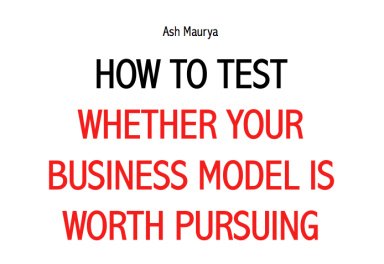
Publication number: ELQ-47924-1
View all versions & Certificate

How to Test Whether Your Business Model is Worth Pursuing
How to asses your business model to see if it's worth taking any further.
Introduction
Last time I emphasized getting specific on your revenue streams — down to the customer segment, pricing model, and customer lifetime assumptions.
In this post, I’m going to show you how to use these simple inputs to ballpark your business model and test whether it’s worth pursuing.
If you don’t have a “big enough” problem worth solving (that’s not even plausible on paper), then why expend any effort on it.
The traditional top-down approach for doing this is attaching your business model to a “large enough” customer segment. Then the logic goes that if you can capture “just 1%” of this large market, you’ll be all set.
After all, 1% of a billion dollar market is still a lot of zeros…
The problems with this approach are that
-it gives you a false sense of comfort,
-it doesn’t address how to get to this 1% market share with your specific product, and finally
-1% market share might not even be the right success criteria for you.
For these reasons, I advocate a different approach.
Before you can test whether your business model is worth pursuing, you need to first ballpark the finished story benefit of your business model.
“If you don’t know where you are going, any road will get you there.”
- Lewis Carroll, Alice in Wonderland
I know this sounds a lot like the “exit question” investors ask and I can already sense your uneasiness. Most people hate this question because it feels like arbitrarily picking yet another large number out of thin air (like a $100M exit goal) and then working excel magic to rationalize the number.
First, this number isn’t quite pulled out of thin air.
We need this number to justify the business model story — first to ourselves and then to our internal and external stakeholders (team, investors, budget gatekeepers, etc.).
$100M represents a return on investment a VC needs to justify their investment across a portfolio of highly risky startups. That said, this number doesn’t have to be $100M and is more a function of your business model incubation environment.
If instead of a startup, you were exploring a new business model in an enterprise setting, there would similarly be some expected return (one with a lot of zeros too) to justify the effort expended.
Even as a solo bootstrapper, you probably have (and if not, should have) some ballpark number to justify your return on effort per project. This could very well be a $100M exit, but could just as well also be generating an extra $1,000/mo of passive income.
There is no right or wrong answer but you should have an answer.
I’ll warn you that this can be a deep (and often uncomfortable) thought exercise that gets to your personal “why”, but the constraints it exposes allow for a more actionable strategy.
And that’s the more important message:
While we all need a ballpark destination to justify the journey, it’s not the destination itself but the starting assumptions and milestones along the way that inform whether we are on the right path or need a course-correction.
.
.
Read on to see how to make this number more actionable…
- Step n°1 |
Determine your Minimum Success Criteria
Instead of thinking in terms of your business model’s maximum upside potential (like the 1% market share goal), I find it more helpful to think in terms of timeboxed minimum success criteria.
If, for instance, you had asked the Google or Facebook founders when they were first starting out whether they thought they would go on to build billion dollar companies, they would probably have laughed at you.
“We built it and we didn’t expect it to be a company,
we were just building this because we thought it was awesome.”
- Mark Zuckerberg
In the case of Google, we know that despite building a very successful search engine (in terms of usage), they struggled for years to find a sustainable business model and even tried to get themselves sold to yahoo for $1M which got turned down. So at that point in time, we could say that their minimum success criteria morphed from whatever it started at to $1M. That didn’t keep the google founders from going on to build a billion dollar company.
No one penalizes you for revising your goal upwards.
Not only is the minimum success criteria easier to estimate than your maximum upside potential, it also helps you model your progress along the way.
Your minimum success criteria is the smallest outcome that would deem the project a success for you X years from now.
Some notes:
1. I like to use X as 3 years and don’t recommend going over 5 years.
The key is picking a time box just far enough into the future that allows you to demonstrate a small scale working version of your business model.
2. I prefer framing the outcome in terms of a yearly revenue number versus profit or a company valuation.
Yearly revenue has fewer inputs which keeps the model simple. The others are optimized derivations of revenue. So as long as you leave yourself enough room, you should be okay.
3. Finally, the outcome does NOT have to be revenue based.
For instance, I wasn’t driven to write my book, Running Lean, by money but impact. Not-for-profit ventures also fall into this category which I’ll cover in a future post.
.
.
That said, the minimum success criteria is just a number and it’s still somewhat decoupled from the actual specifics in your business model.
Lets see how we tie the two together.
add_shopping_cartContinue reading for free (70% left)

